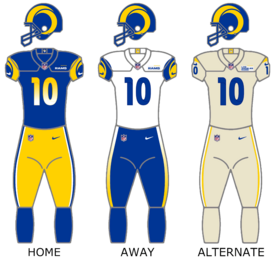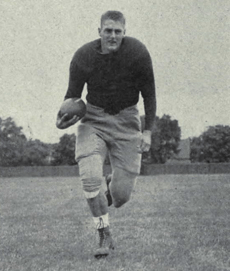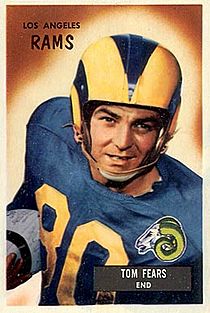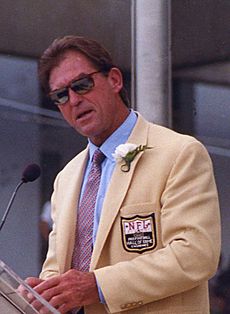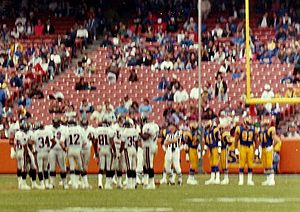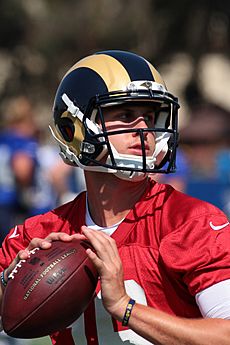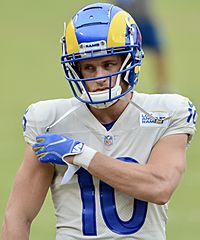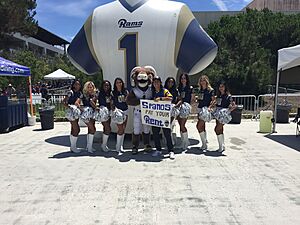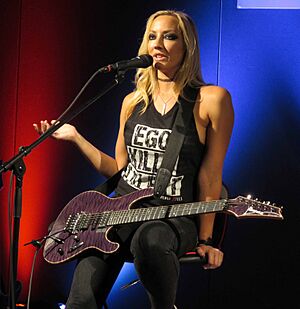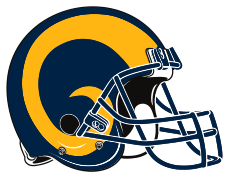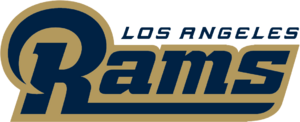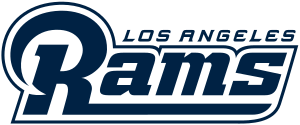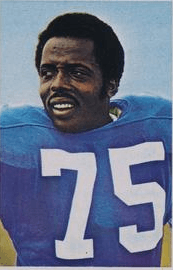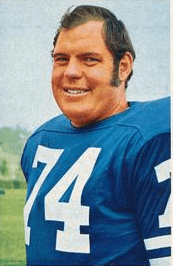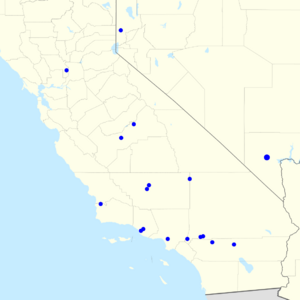Los Angeles Rams facts for kids
Quick facts for kids Los Angeles Rams |
|||||||||||||
|---|---|---|---|---|---|---|---|---|---|---|---|---|---|
|
|||||||||||||
| Basic info | |||||||||||||
| Established | April 11, 1936 | ||||||||||||
| Stadium | SoFi Stadium Inglewood, California |
||||||||||||
| Headquartered | Kroenke Warner Center Los Angeles, California |
||||||||||||
| Colors | Royal blue, sol |
||||||||||||
| Mascot | Rampage | ||||||||||||
| Personnel | |||||||||||||
| Owner(s) | Stan Kroenke | ||||||||||||
| Chairman | Stan Kroenke | ||||||||||||
| CEO | Stan Kroenke | ||||||||||||
| President | Kevin Demoff | ||||||||||||
| General manager | Les Snead | ||||||||||||
| Head coach | Sean McVay | ||||||||||||
| Nicknames | |||||||||||||
|
|||||||||||||
| Team history | |||||||||||||
|
|||||||||||||
| Home fields | |||||||||||||
|
|||||||||||||
| League / conference affiliations | |||||||||||||
| American Football League (1936) National Football League (1937–present)
|
|||||||||||||
| Championships | |||||||||||||
League championships: 4
|
|||||||||||||
Conference championships: 8
|
|||||||||||||
Division championships: 19
|
|||||||||||||
| Playoff appearances (33) | |||||||||||||
|
|||||||||||||
| Owner(s) | |||||||||||||
|
|||||||||||||
The Los Angeles Rams are a professional American football team. They are based in the Greater Los Angeles area. The Rams play in the National Football League (NFL). They are part of the National Football Conference (NFC) West division.
The team plays its home games at SoFi Stadium in Inglewood, California. They share this stadium with the Los Angeles Chargers. The Rams' main office is at the Rams Village at Warner Center in Los Angeles.
The team started in 1936 as the Cleveland Rams in Cleveland, Ohio. They won the 1945 NFL Championship Game. After that, they moved to Los Angeles in 1946. This made them the only NFL champion team to play in a different city the next season.
The club played at the Los Angeles Memorial Coliseum until 1980. Then, they moved to Anaheim Stadium in Orange County, California. The Rams reached their first Super Bowl in 1979. They lost Super Bowl XIV to the Pittsburgh Steelers.
After the 1994 NFL season, the Rams moved to St. Louis, Missouri. They became the St. Louis Rams. Five seasons later, they won Super Bowl XXXIV against the Tennessee Titans. This was the start of their "Greatest Show on Turf" era. They also played in Super Bowl XXXVI but lost to the New England Patriots.
After the 2015 NFL season, the team moved back to Los Angeles for the 2016 NFL season. The Rams played in Super Bowl LIII but lost to the Patriots. Three years later, the Rams won Super Bowl LVI against the Cincinnati Bengals. They became the second NFL team to win the Super Bowl in their home stadium.
The Rams are the only NFL team to win championships in three different cities. They won in Cleveland in 1945. They won in St. Louis in 1999. And they won in Los Angeles in 1951 and 2021.
Contents
Team History
Early Years in Cleveland (1936–1945)
The Cleveland Rams started on April 11, 1936. They were founded by Homer Marshman and Damon Wetzel. Wetzel chose the name "Rams" because he liked the Fordham Rams college team. The team first played in the American Football League.
The Rams joined the National Football League in 1937. They were the fourth team from Cleveland to join the NFL. They played in three different stadiums and had many losing seasons. However, Parker Hall was named the league's Most Valuable Player in 1939.
In 1941, Dan Reeves bought the team. The team stopped playing in 1943 because many players were away fighting in World War II. They started playing again in 1944.
Winning the NFL Championship (1945)
The team finally found success in 1945. This was their last season in Ohio. Adam Walsh became the head coach. Rookie quarterback Bob Waterfield was named the league's Most Valuable Player. He helped the Rams win their first NFL Championship. They beat the Washington Redskins 15–14. The winning points came from a "safety" when a Redskins' pass hit the goal post. After this game, the NFL changed the rules so this could not happen again.
Moving to Los Angeles (1946–1994)
On January 12, 1946, owner Dan Reeves wanted to move the Rams to Los Angeles. Other NFL owners first said no. Reeves then said he would leave the NFL if he couldn't move the team. So, the NFL allowed the move. This made the NFL the first professional sports league to have teams on both coasts.
The Rams also agreed to a special condition to play in Los Angeles. They had to sign at least one African-American player. On March 21, 1946, the Rams signed Kenny Washington. They added Woody Strode on May 7, 1946. This made the Rams the first NFL team to have black players in many years.
The Rams were the first NFL team to play in Los Angeles. They shared the Los Angeles Memorial Coliseum with another team, the Los Angeles Dons. The Rams' first preseason game in L.A. had 95,000 fans. They finished their first season in L.A. with a good record.
In 1948, Fred Gehrke painted horns on the Rams' helmets. This was the first helmet logo in professional football.
Winning the NFL Championship Again (1951)
The Rams were very strong in Southern California from 1949 to 1955. They played in the NFL Championship Game four times and won once in 1951. They had a powerful offense with players like Elroy Hirsch, Bob Waterfield, and Norm Van Brocklin.
Elroy Hirsch was one of the first "big play" receivers. In their 1951 championship season, he gained 1,495 receiving yards and scored 17 touchdowns. In 1950, the Rams were the first pro football team to have all their games shown on TV.
In the late 1950s and early 1960s, other major sports teams moved to Los Angeles. Even with more competition, the Rams remained popular. They often had huge crowds at the Coliseum.
The 1960s were known for the "Fearsome Foursome" defensive line. This group included Rosey Grier, Merlin Olsen, Deacon Jones, and Lamar Lundy. They helped the team become strong again in 1967. That year, the Rams were the first NFL team to have over one million fans attend their games in a season.
Coach George Allen led the Rams from 1966 to 1970. He brought in new ideas, like hiring Dick Vermeil as one of the first special teams coaches. The Rams had winning seasons under Allen but did not win a playoff game.
Quarterback Roman Gabriel played for the Rams for 11 seasons. He was named the NFL's MVP in 1969.
In 1972, Carroll Rosenbloom became the new owner. The Rams continued to be strong in the 1970s. They won seven straight division titles from 1973 to 1979. However, they lost several conference championship games.
The Chuck Knox and Ray Malavasi Years (1973–1982)
Chuck Knox was the head coach during this time. His teams had strong defenses. Jack Youngblood was a famous defensive player for the Rams in the 1970s. He was known for his toughness, even playing with a broken leg. Some Rams players, like Fred Dryer and Merlin Olsen, became actors after their football careers.
In 1979, the Rams had a 9–7 record. They surprised many by beating the Dallas Cowboys and the Tampa Bay Buccaneers to reach their first Super Bowl. They played the Pittsburgh Steelers in Super Bowl XIV. The game was played in Pasadena, California, close to home for the Rams. They played well but lost 31–19.
Before the 1979 NFL season, owner Carroll Rosenbloom passed away. His wife, Georgia Frontiere, became the new owner. In 1980, the Rams moved from the Coliseum to Anaheim Stadium in Orange County. The Coliseum was very large, and games often didn't sell out, so they couldn't be shown on local TV. The new stadium was smaller, making it easier to sell out games.
In the early 1980s, the Rams struggled. Other popular sports teams, like the Los Angeles Lakers and Los Angeles Dodgers, were winning championships. This made the Rams less popular for a while.
The John Robinson Years (1983–1991)
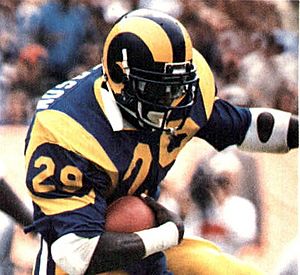
The team hired coach John Robinson in 1983. He helped the team improve. They made the playoffs in 1983 and 1984. In 1985, they reached the NFC Championship Game but lost to the Chicago Bears.
Eric Dickerson was a star running back for the Rams during this time. In 1984, he rushed for 2,105 yards, which is still an NFL record. He was traded in 1987 after a contract disagreement. Even after Dickerson left, the Rams remained strong. They had a talented quarterback in Jim Everett and good receivers like Henry Ellard.
The Rams had a great season in 1989. They won their first five games and reached the NFC Championship Game. However, they lost to the San Francisco 49ers. This was the last time the Rams had a winning season in Los Angeles before moving to St. Louis.
Chuck Knox Returns (1992–1994)
Chuck Knox returned as head coach in 1992, but the team continued to struggle. Their offense was not exciting, and the team kept losing. Fans became less interested. Jerome Bettis was a bright spot during this time. He was a strong running back who gained many yards.
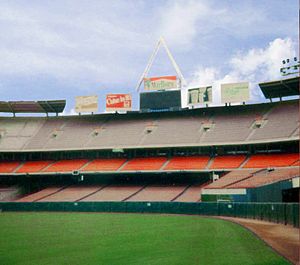
The Rams felt their stadium was a problem. Anaheim Stadium was built for baseball, so it wasn't great for football. The team couldn't get a new stadium in Los Angeles. This made their future in Southern California uncertain.
Owner Georgia Frontiere decided to move the team to St. Louis. At first, other NFL owners said no. But Frontiere threatened to sue the league. To avoid a long legal fight, the owners eventually allowed the move. The Rams left Los Angeles for St. Louis in 1995.
Years in St. Louis (1995–2015)
The Rams' first two seasons in St. Louis were tough. They had losing records. Isaac Bruce was a popular player during this time.
The "Greatest Show on Turf" Era (1997–2005)
In 1997, Dick Vermeil became the head coach. The team also drafted Orlando Pace, a future star offensive lineman. The Rams struggled for two more seasons.
Winning Super Bowl XXXIV (1999)
The 1999 season started with a big challenge. Their starting quarterback, Trent Green, got hurt. Backup quarterback Kurt Warner took over. Warner had played in smaller leagues before. Coach Vermeil said the team would "Rally around Kurt Warner."
Warner, along with Marshall Faulk and Isaac Bruce, led the Rams to an amazing offense. They scored 526 points that season. This team became known as "The Greatest Show on Turf". Warner threw for 41 touchdowns. The Rams reached Super Bowl XXXIV and beat the Tennessee Titans 23–16. Warner was named the Super Bowl MVP.
After the Super Bowl win, Vermeil retired. Mike Martz, the team's offensive coordinator, became the new head coach. He led the Rams to Super Bowl XXXVI, but they lost to the New England Patriots 20–17. The Rams' offense was one of the best in NFL history during these years.
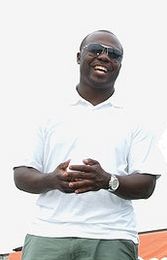
The Rams drafted running back Steven Jackson in 2004. Coach Martz was sometimes criticized for his game decisions. He also had disagreements with some players and team leaders. In 2005, Martz became ill and couldn't coach. He was later fired.
After Martz, Scott Linehan became head coach. The team continued to struggle. In 2008, owner Georgia Frontiere passed away. Her children took over the team. Linehan was fired after the team started 0–4 in 2008.
In 2009, Steve Spagnuolo became the new head coach. His first season was tough, with the team winning only one game.
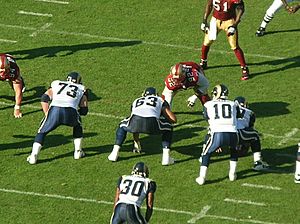
In 2009, the owners decided to sell the team. Minority owner Stan Kroenke bought the rest of the team. Kroenke also owned other sports teams. He had to transfer ownership of those teams to his son to follow NFL rules.
The Rams had the first pick in the 2010 NFL draft after a 1–15 record in 2009. They chose quarterback Sam Bradford. Bradford was named the NFL's Offensive Rookie of the Year in 2011. Running back Steven Jackson became the team's all-time leading rusher in 2010.
The Rams' stadium in St. Louis, the Edward Jones Dome, was supposed to be a "top tier" NFL stadium. If it wasn't, the Rams could break their lease. The stadium was not ranked highly, and negotiations to improve it failed.
In 2015, the Rams traded quarterback Sam Bradford for Nick Foles. They also drafted running back Todd Gurley. The Rams played their last home game in St. Louis on December 17, 2015. Fans in St. Louis felt that owner Stan Kroenke had not been honest about wanting to keep the team there. The NFL owners eventually voted to let the Rams move back to Los Angeles.
Return to Los Angeles (2016–Present)
In 2015, Stan Kroenke planned to build a new NFL stadium in Inglewood. The city approved the stadium. The Rams moved to their new stadium, SoFi Stadium, in 2020.

On January 12, 2016, NFL owners voted 30–2 to allow the Rams to return to Los Angeles. The Rams held a press conference to announce their return. They played at the Los Angeles Memorial Coliseum as a temporary home from 2016 to 2019.
The Rams chose Oxnard for their minicamp in 2016. They also appeared on the TV show Hard Knocks. In April 2016, the Rams traded for the first pick in the 2016 NFL draft. They used it to select quarterback Jared Goff.
The Rams sold many season tickets for their return. They played their first preseason game in L.A. since 1994 against the Dallas Cowboys. Over 89,000 fans attended. On September 18, 2016, the Rams won their first regular-season home game in L.A. since 1994, beating the Seattle Seahawks 9–3.
The team fired head coach Jeff Fisher in December 2016 after a 4–9 start.
The Sean McVay Era (2017–Present)
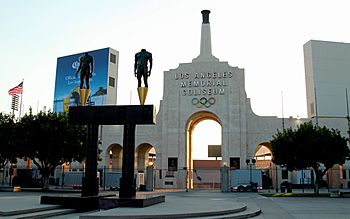
On January 12, 2017, Sean McVay became the new head coach. At 30 years old, he was the youngest head coach in modern NFL history.
The Rams had a great turnaround season in 2017. Jared Goff and Todd Gurley played much better. New receivers like Sammy Watkins, Robert Woods, and Cooper Kupp joined the team. Many compared this team to the "Greatest Show on Turf" Rams.
The Rams won their division in 2017, their first division title since 2003. They finished with an 11–5 record. They lost in the first round of the playoffs. However, they led the league in points scored after being the worst in 2016.
In 2018, the Rams added more star players like Marcus Peters, Aqib Talib, and Ndamukong Suh. They also traded for receiver Brandin Cooks. The team signed Todd Gurley and Aaron Donald to big contracts. Aaron Donald became the highest-paid defensive player in NFL history at the time.
The Rams started the 2018 season very strong, winning their first eight games. They were the last undefeated team in the NFL before losing to the New Orleans Saints. They finished the season with a 13–3 record, one of the best in team history.
The Rams beat the Dallas Cowboys in the playoffs. Then, they beat the Saints in a close game to reach the Super Bowl. This was their first Super Bowl appearance as a Los Angeles team since 1980. The game against the Saints had a controversial play where a penalty was not called.
The Rams lost Super Bowl LIII to the New England Patriots 13–3. It was the lowest-scoring Super Bowl ever.
In 2019, Todd Gurley dealt with a knee injury. The team made some trades, including sending Marcus Peters to the Baltimore Ravens. They also traded for star cornerback Jalen Ramsey. The Rams struggled with injuries on their offensive line. They finished the season 9–7 and missed the playoffs.
The 2020 season was affected by the global pandemic. There was no preseason. The Rams released Todd Gurley and traded Brandin Cooks. They drafted new players like running back Cam Akers and receiver Van Jefferson. Jalen Ramsey signed a huge contract, making him the highest-paid cornerback.
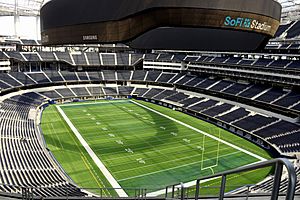
The 2020 season marked the opening of the new SoFi Stadium. Fans could not attend games in its first year due to the pandemic. The Rams won their first game at the new stadium against the Cowboys. They finished the season 10–6 and made the playoffs.
In the playoffs, quarterback Jared Goff played with a thumb injury. The Rams beat the Seattle Seahawks in the Wild Card round. They then lost to the Green Bay Packers in the Divisional round.
Winning Super Bowl LVI (2021)
Before the 2021 season, the Rams made a big trade. They sent Jared Goff to the Detroit Lions for quarterback Matthew Stafford. They also lost some defensive players but added DeSean Jackson and Sony Michel.
The Rams opened their 2021 season at SoFi Stadium with fans for the first time. Matthew Stafford played great in his first game. The Rams started strong, beating the Tampa Bay Buccaneers. They then traded for star linebacker Von Miller and signed receiver Odell Beckham Jr..
Despite these additions, the Rams lost three straight games. But they bounced back, winning five games in a row. They clinched their division title with a 12–5 record. Cam Akers, who had a serious injury, made a quick return for the playoffs.
In the playoffs, the Rams beat the Arizona Cardinals easily. They then faced the Tampa Bay Buccaneers and almost lost a big lead. But Matthew Stafford and Cooper Kupp connected for a game-winning field goal. In the NFC Championship, the Rams beat the San Francisco 49ers in a close game. This sent them to Super Bowl LVI.
In the Super Bowl, the Rams played the Cincinnati Bengals. They took an early lead. Cooper Kupp and Odell Beckham Jr. scored touchdowns. Beckham Jr. got hurt in the first half. The Bengals took the lead in the second half. But Stafford and Kupp connected again for a game-winning touchdown. On the Bengals' final play, Aaron Donald made a key tackle. The Rams won their second Super Bowl, 23–20. They were the second team to win the Super Bowl in their home stadium.
After the Super Bowl, Aaron Donald and Sean McVay decided to return. Donald signed a new contract. The Rams also signed receiver Allen Robinson and linebacker Bobby Wagner.
In 2022, Rams owner Stan Kroenke bought more land in Woodland Hills. This land is planned to become the team's permanent headquarters and practice facility.
Challenges and Rebuilding (2022–2023)
The Rams' 2022 season started with a loss. Injuries became a big problem for the team. Key players like Matthew Stafford, Cooper Kupp, and Aaron Donald were all injured. The team signed quarterback Baker Mayfield, who led a dramatic last-minute win. However, the Rams finished with a 5–12 record, the worst ever for a defending Super Bowl champion.
In 2023, the Rams made changes to manage their team salary. They traded or released several important players. Cooper Kupp was injured at the start of the season. Rookie receiver Puka Nacua stepped up and played a huge role. Running back Kyren Williams also became a key player.
The Rams had a tough start but improved later in the season. They won many games and made the playoffs. Puka Nacua broke two NFL rookie records for most catches and receiving yards.
In the playoffs, the Rams played the Detroit Lions. It was a close game, but the Rams lost 24–23.
After Aaron Donald (2024–Present)
On March 15, 2024, superstar defensive tackle Aaron Donald announced his retirement. He played his entire 10-year career with the Rams. He was known as one of the best defensive players ever.
The Rams signed new defensive players like Darious Williams and Kamren Curl. They also signed quarterback Jimmy Garoppolo as a backup. In the 2024 NFL draft, the Rams had a first-round pick for the first time since 2016. They drafted linebackers Jared Verse and Braden Fiske.
The Rams held training camp at Loyola Marymount University in 2024. They later moved to their new permanent practice facility in Woodland Hills.
The 2024 season began with injuries to key players like Puka Nacua and Cooper Kupp. The Rams started with a 1–4 record. However, they made a great comeback win against the San Francisco 49ers. They then went on a winning streak as injured players returned.
The Rams won their division in 2024. They played the Minnesota Vikings in the Wild Card game. Due to wildfires in Los Angeles, the game was moved to Arizona. The Rams dominated the Vikings, winning 27–9. They set an NFL playoff record with nine sacks. The Rams then lost to the Philadelphia Eagles in the Divisional round.
In 2026, the Rams will play a regular season NFL game in Melbourne, Australia. This will be the first NFL game played in Australia.
Team Value
Forbes magazine estimated the Rams' value at $1.45 billion in 2015. After moving back to Los Angeles, their value grew to $2.9 billion. In 2021, Forbes ranked the Rams as the fourth most valuable NFL team at $4.8 billion. The team's success in Los Angeles has helped them gain many new fans.
| Year | Value | Change | NFL | LA | US | World |
|---|---|---|---|---|---|---|
| 2017 | $3.0B | #6 | #2 | #9 | #12 | |
| 2018 | $3.2B | #4 | #2 | #10 | #14 | |
| 2019 | $3.8B | #4 | #3 | #9 | #12 | |
| 2020 | $4.0B | #4 | #2 | #8 | #11 | |
| 2021 | $4.8B | #4 | #2 | #8 | #13 |
Team Culture
Mascot
Rampage
Rampage has been the Rams' official mascot since 2010. Fans voted for him when the team was in St. Louis. Rampage is known for being energetic and fun.
Fans
Melonheads
In the 1980s, a fan named Lance Goldberg started a trend. He wore a watermelon on his head with horns, like the "Cheesehead" hats of Green Bay Packers fans. Goldberg was honored in the Pro Football Hall of Fame in 2000.
Mob Squad
During their last season in St. Louis in 2015, the Rams called their defense "The Mob Squad." This name also refers to a group of sheep. The team stopped using the name after 2018, but many fan clubs still use it. It is now used to describe all Rams fans.
Famous Fans
Many famous people from Los Angeles have supported the Rams. This includes actors and musicians. Actor Terry Crews was even drafted by the Rams in 1991.
Nita Strauss
Nita Strauss, a guitarist for Alice Cooper, joined the Rams' entertainment team in 2018. She often plays guitar riffs at home games to get the crowd excited. After the Rams won Super Bowl LVI, she received a Super Bowl ring.
Nelly
When the team was in St. Louis, rapper Nelly was a big fan. He wore Rams gear in his music videos. In 2002, Nelly invited Rams players like Torry Holt and Marshall Faulk to appear in his music video for "Air Force Ones". Nelly was upset when the team moved back to Los Angeles but still supports them.
Red Hot Chili Peppers
When the Rams returned to Los Angeles in 2016, the band Red Hot Chili Peppers played a concert before a game. Bassist Flea and drummer Chad Smith are big fans and have season tickets. After the Rams won Super Bowl LVI, the band released a special vinyl album in the team's colors. At home games, Nita Strauss often plays a riff from their song "Can't Stop".
Team Rivalries
Division Rivals
San Francisco 49ers
The Rams have a long rivalry with the San Francisco 49ers. It goes back to the 1950s when both teams were in the same division. They often fought for control of California football. The 49ers usually won in the 1980s.
Even when the Rams moved to St. Louis, the rivalry continued. It became even stronger when the Rams returned to Los Angeles in 2016. Sports Illustrated calls it the 8th best rivalry in the NFL. Both teams have been in the NFC West since 1970.
Coaches Sean McVay (Rams) and Kyle Shanahan (49ers) both worked for the Washington Redskins before. They have both helped their teams become strong again. In the 2021–22 season, the 49ers had beaten the Rams six times in a row. But the Rams won the NFC Championship Game that year. The Rams then won Super Bowl LVI.
Seattle Seahawks
The Rams' rivalry with the Seattle Seahawks started in 2002 when the Seahawks joined the NFC West. They had a notable playoff game in 2004, where the Rams won.
The rivalry became more intense in the 2010s. Both teams had strong defenses and fought for the division title. There were some heated moments between players. The teams have won two Super Bowls and seven division titles since 2010.
The Rams beat the Seahawks in a playoff game in 2021. The series is currently tied 27–27, but the Rams have won both playoff games.
Arizona Cardinals
This is one of the oldest rivalries for the Rams. They first played in 1937 when the Rams were in Cleveland and the Cardinals were in Chicago. The rivalry has become stronger recently as both teams have been successful.
The Rams have a good record against the Cardinals under coach Sean McVay. In 2020, the Rams beat the Cardinals in a game that helped them make the playoffs. The Rams lead the all-time series 47–39–2, with two playoff wins.
Conference Rivals
Dallas Cowboys
The rivalry between the Dallas Cowboys and the Los Angeles Rams was big in the 1970s and 1980s. They played eight times during that period. The Cowboys won two of those games that decided who would go to the Super Bowl. The Cowboys lead the all-time series 20–18, but the Rams lead 5–4 in playoff games.
New Orleans Saints
The Rams and New Orleans Saints used to be in the same division until 2002. The rivalry became intense again in the 2010s. There was a lot of talk between the teams in the media.
A very controversial play happened in the 2018 NFC Championship Game. A Rams player made contact with a Saints receiver, but no penalty was called. This upset the Saints and their fans. The teams are tied 1–1 in the playoffs, but the Rams lead the all-time series 44–35.
Detroit Lions
The Rams have played the Detroit Lions more than any other team outside their division. They have played 89 times since 1937. In the 2023–24 playoffs, the Rams and Lions met in the postseason for the first time since 1952. The Lions won a very close game. The Rams lead the all-time series 45–43–1.
Other Rivals
Los Angeles Raiders/Los Angeles Chargers
This rivalry was first called the "Battle of Los Angeles" when the Raiders were in Los Angeles from 1982 to 1994. The rivalry stopped when both teams moved away.
It started again when the Los Angeles Chargers moved to Los Angeles in 2017. In 2017, there was a fight between players from both teams during a practice. The Rams and Chargers now share SoFi Stadium. The two teams are tied 1–1 in regular season games in Los Angeles.
Historic Rivals
Minnesota Vikings
The Rams' rivalry with the Minnesota Vikings was most intense in the 1970s. They played many important playoff games. The Vikings are the Rams' second most common playoff opponent. The Vikings lead the all-time series 27–19–1 and are 5–3 in the playoffs.
Kansas City Chiefs
When the Rams were in St. Louis, they had a rivalry with the Kansas City Chiefs. A trophy was given to the winner of their games. This rivalry ended when the Rams moved back to Los Angeles. Their game in 2018 was one of the highest-scoring games ever. The Chiefs lead the all-time series 8–5.
Team Logos and Uniforms
The Rams were the first NFL team to have a logo on their helmets. In 1948, Fred Gehrke painted ram horns on their leather helmets. This horn design has been the team's symbol ever since.
When the team started in 1937, their colors were red and black. A year later, they changed to gold and royal blue. By the mid-1940s, they wore gold jerseys with navy blue numbers.
The helmets changed to navy blue in 1947. The horns were painted yellow-gold. In 1949, the team started using plastic helmets with the horn design baked in.
In 1964, the colors changed to a simpler blue and white. The new helmet horns were white and wider. The Rams often wore white jerseys for home games during this time.
In 1973, yellow-gold was brought back. The new uniforms had yellow-gold pants and curling ram horns on the sleeves. The Rams mostly wore blue jerseys at home. In 1981, the gray face masks on the helmets became navy blue.
On April 12, 2000, the St. Louis Rams introduced new logos and colors. The main colors changed to "Millennium Blue" and "New Century Gold." A new ram's head logo was added to the sleeves. The helmet design stayed similar, with gold horns on a navy blue helmet.
When the Rams moved back to Los Angeles in 2016, they made small changes to their logo. The location name changed from St. Louis to Los Angeles. The team kept its colors and uniforms at first.
In 2017, the Rams started wearing helmets similar to their "Fearsome Foursome" era. These were blue helmets with white horns and a white face mask. They also started using a blue and white logo as their main one, slowly removing gold from their color scheme.
On July 27, 2018, the Rams announced they would wear their royal blue and yellow throwback uniforms for home games. They stopped using their navy blue and metallic gold uniforms.
On March 23, 2020, the Rams showed off new logos and colors. The main logo has "LA" letters with a ram's horn. The new colors are "Rams Royal" (royal blue) and "Sol" (yellow). Many fans did not like the new logo at first.
The Rams showed their new uniform designs on May 13, 2020. They introduced royal blue jerseys with yellow and white numbers. They also had a new "bone grey" road jersey. All uniforms used a new metallic blue helmet with blue facemasks and new horn designs.
On July 13, 2021, the Rams revealed a white alternate uniform. This was a modern version of their old road uniform from 1973–1999. The Rams wore these white uniforms with yellow pants when they won Super Bowl LVI.
In 2022, the white uniform became their main road uniform, replacing the bone grey one.
Season Records
The table below shows the Rams' records for the last five seasons and how they did in the playoffs. The Los Angeles Rams made the playoffs in four of the last five seasons. They won Super Bowl LVI in the 2021 NFL season. They also played in the Super Bowl after the 2018 NFL season. Recent awards include Sean McVay winning NFL Coach of the Year in 2017 and Cooper Kupp winning Super Bowl MVP in 2021.
Note: GP = Games played, W = Wins, L = Losses, W–L% = Winning percentage
| Season | GP | W | L | W–L% | Finish | Playoffs |
| 2020 | 16 | 10 | 6 | .625 | 2nd, NFC West | Lost in Divisional, 18–32 (Packers) |
| 2021 | 17 | 12 | 5 | .706 | 1st, NFC West | NFL champions, 23–20 (Bengals) |
| 2022 | 17 | 5 | 12 | .294 | 3rd, NFC West | did not qualify |
| 2023 | 17 | 10 | 7 | .588 | 2nd, NFC West | Lost in Wild Card, 23–24 (Lions) |
| 2024 | 17 | 10 | 7 | .588 | 1st, NFC West | Lost in Divisional, 22–28 (Eagles) |
Famous Players
Current Roster
|
Los Angeles Rams roster
|
|||||||||
|---|---|---|---|---|---|---|---|---|---|
Quarterbacks
Running backs
Wide receivers
Tight ends
|
Offensive linemen
Defensive linemen
|
Linebackers
Defensive backs
Special teams
|
Reserve lists
→ AFC rosters → NFC rosters |
||||||
Retired Numbers
The Rams have retired these jersey numbers to honor special players:
| Los Angeles Rams retired numbers | ||||
|---|---|---|---|---|
| No. | Player | Position | Years Played | Number Retired |
| 7 | Bob Waterfield | QB | 1945–1952 | 1952 |
| 28 | Marshall Faulk | RB | 1999–2005 | December 21, 2007 |
| 29 | Eric Dickerson | RB | 1983–1987 | |
| 74 | Merlin Olsen | DT | 1962–1976 | December 12, 1982 |
| 75 | Deacon Jones | DE | 1961–1971 | September 27, 2009 |
| 78 | Jackie Slater | OT | 1976–1995 | November 24, 1996 |
| 80 | Isaac Bruce | WR | 1994–2007 | October 31, 2010 |
| 85 | Jack Youngblood | DE | 1971–1984 | December 23, 1985 |
Hall of Famers
Many former Rams players are in the Pro Football Hall of Fame. These include Joe Namath, Marshall Faulk, Orlando Pace, Kurt Warner, and Bob Waterfield. Some coaches and team leaders are also in the Hall of Fame for their work with the Rams or other teams.
| Cleveland / St. Louis / Los Angeles Rams Hall of Famers | ||||
|---|---|---|---|---|
| Players | ||||
| No. | Name | Inducted | Position(s) | Years Played |
| 36 | Jerome Bettis | 2015 | RB | 1993–1995 |
| 76 | Orlando Pace | 2016 | OT | 1997–2008 |
| 91 | Kevin Greene | 2016 | LB | 1985–1992 |
| 76 | Bob Brown | 2004 | OT | 1969–1970 |
| 80 | Isaac Bruce | 2020 | WR | 1994–2007 |
| 29 | Eric Dickerson | 1999 | RB | 1983–1987 |
| 28 | Marshall Faulk | 2011 | RB | 1999–2006 |
| 55 | Tom Fears | 1970 | End | 1948–1956 |
| 40 | Elroy "Crazy Legs" Hirsch | 1968 | RB, WR | 1949–1957 |
| 75 | Deacon Jones | 1980 | DE | 1961–1971 |
| 65 | Tom Mack | 1999 | G | 1966–1978 |
| 74 | Merlin Olsen | 1982 | DT | 1962–1976 |
| 67, 48 | Les Richter | 2011 | LB, K | 1954–1962 |
| 78 | Jackie Slater | 2001 | OT | 1976–1995 |
| 11 | Norm Van Brocklin | 1971 | QB, P | 1949–1957 |
| 10, 13 | Kurt Warner | 2017 | QB | 1998–2003 |
| 7 | Bob Waterfield | 1965 | QB, DB, K, P | 1945–1952 |
| 33 | Ollie Matson | 1972 | RB | 1959–1962 |
| 85 | Jack Youngblood | 2001 | DE | 1971–1984 |
| Coaches and Contributors | ||||
| Name | Inducted | Position(s) | Years Played | |
| Dick Vermeil | 2022 | Coach | 1969, 1971–1973, 1997–1999 | |
| George Allen | 2002 | Coach | 1966–1970 | |
| Dan Reeves | 1967 | Owner | 1941–1971 | |
St. Louis Football Ring of Fame
The St. Louis Football Ring of Fame honored former Rams players and coaches. It was located at the team's stadium in St. Louis. Most players in the Ring of Fame are also in the Pro Football Hall of Fame.
Awards
Radio and Television
The Rams were the first NFL team to show their home games on TV. This happened in 1950. The 1951 NFL Championship Game was the first championship game shown across the whole country.
When the team was first in Los Angeles, their games were on KMPC radio. Famous announcers like Dick Enberg called the games.
When the team moved to St. Louis, they had different radio stations. Steve Savard was a long-time play-by-play announcer.
After the Rams returned to Los Angeles, KCBS-TV started showing their preseason games. Andrew Siciliano is the play-by-play announcer for these games. Eric Dickerson and Marshall Faulk, both Hall of Famers, used to provide commentary.
For regular season games, Fox usually shows most Rams games. NBC shows NBC Sunday Night Football games. ABC shows Monday Night Football games. All Rams home games are shown on TV in Los Angeles.
Since 2016, KSPN-AM and KCBS-FM are the Rams' official English radio stations. KWKW provides Spanish-language coverage.
Radio Stations
Source:
English Stations
| City | Call Sign | Radio Frequency |
|---|---|---|
| Los Angeles (Flagship station) | KSPN | 710 AM |
| KCBS | 93.1 FM | |
| Bakersfield | KHTY | 970 AM |
| Banning | KMET | 1490 AM |
| Fresno | KKBZ | 105.1 FM |
| Palm Springs | KKUU | 103.9 FM |
| Ridgecrest | KWDJ | 1360 AM |
| Riverside | KTIE | 590 AM |
| San Bernardino | KTIE | 590 AM |
| Santa Barbara | KTMS | 990 AM / 97.9 FM |
| San Diego | XEPRS | 1090 AM |
| Santa Maria | KSMA | 1240 AM / 99.5 FM |
Spanish Stations
| City | Call Sign | Radio Frequency |
|---|---|---|
| Los Angeles (Flagship station) | KWKW | 1330 AM |
| Bakersfield | KWAC | 1490 AM |
| Fresno | KGST | 1600 AM |
| Oxnard | KXLM | 102.9 FM |
| KOXR | 910 AM | |
| Pomona | KTMZ | 1220 AM |
| Riverside | KCAL | 1410 AM |
| Sacramento | KSAC | 890 AM |
| Ventura | KXLM | 102.9 FM |
| KOXR | 910 AM |
See also
 In Spanish: Los Angeles Rams para niños
In Spanish: Los Angeles Rams para niños



